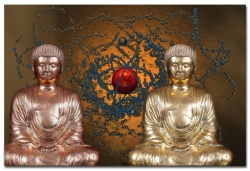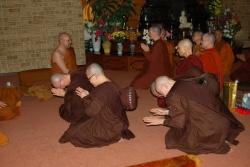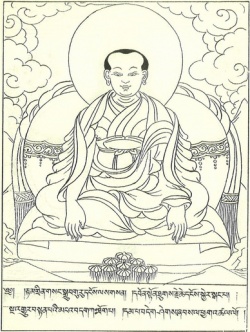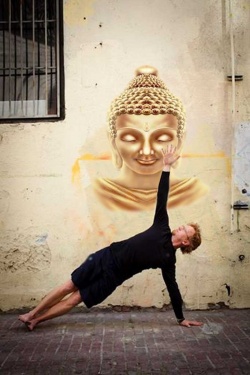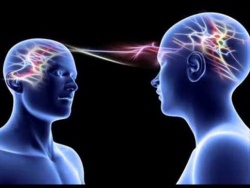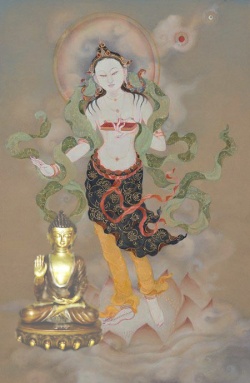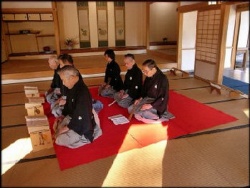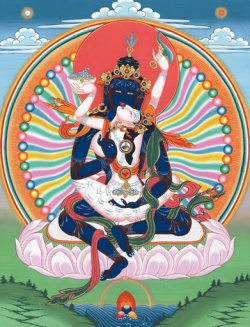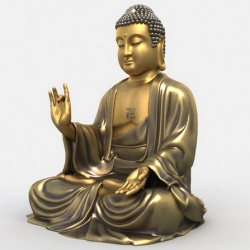Buddhist meditation and personal construct psychology
The following is a contribution to Serendip by Phouttasone (Pilou) Thirakoul, who wrote it during her senior year (1996-1997) as a Psychology major and Neural and Behavioral Sciences concentrator at Bryn Mawr College. Pilou's essay provides a useful introduction to both Buddhist thinking in relation to brain and behavior, and to a branch of western psychology which, with its stress on active generation and regeneration of self, is of considerable interest from a Serendip perspective.
Pilou's essay also represents an example of the benefits to be gained by looking at problems from multiple perspectives, and as encouragement to further thinking about the relations between psychological, neuroscientific, and spiritual approaches to problems of consciousness and self-hood.
Introduction
This paper seeks to examine the phenomenon of Buddhist meditation within the context of a Western psychological personality theory called Personal Construct Psychology. Formulated nearly twenty-five hundred years apart (Buddhist meditation by the 5th century B.C.
Indian teacher Siddhartha Gautama; the Psychology of Personal Constructs, by the 20th century A.D. American psychologist George Kelly), the doctrines expressed in each tradition inevitably reveal differences between one another.
But what is most fascinating is that even despite their differences, striking and illuminating points of correspondence can be observed between the principles of meditation and the theory of human consciousness articulated by Kelly. In light of the growing Western interest in meditative practice as a potentially useful tool in clinical practice and research, and in light of the sustained popularity of George Kelly's constructivist theory of personality in clinical application, it seems worthy to explore possible commonalities between them.
But first, to express the sentiments of a skeptic: To what extent is it truly possible to draw any meaningful comparisons between an Eastern religious practice such as meditation, and a Western intellectual theory, such as Personal Construct Psychology?
The question raises at least two important issues:
1) a cultural issue of the difficulty of understanding an Eastern phenomenon from a Western perspective (and vice versa), and
2) the difficulty of understanding a soteriological experience from an intellectual standpoint (and vice versa).
The first challenge can be confronted by recognizing the ubiquity of meditation, that is, recognizing that meditation is not unique to Eastern religions. For example, West (1990) describes certain Western Christian forms of meditation, citing St. Augustine, St. Theresa, The Desert Fathers, and a certain Fray Francisco de Osuna, whose meditative practices very closely resembled Buddhist techniques.
The East-West polarity is further dissolved by the recognition of Buddhism's similarity to Western philosophy and psychology; most notably, the correspondences observed between Buddhism and Freudian psychoanalysis (de Silva, 1991; Claxton, 1990; Delmonte, 1990; Delmonte, 1989).
There are resonances of Buddhism in the works of Nietzsche (Abe, 1981), Martin Heidegger (Fu, 1981), and Carl Jung (Jung, 1963); along with an acknowledgment of similar social ethics between Buddhism and Aristotle's Nicomachean Ethics (de Silva, 1989).
The second issue, that of attempting to intellectualize a soteriological phenomenon (or, conversely, of attempting to apply a religious experience to academic analysis), has been addressed by Blofeld (1981), who acknowledges this tension between the mysticism of religion and the intellectual ratiocination of philosophical inquiry. However, Buddhism is unique in its particular amenability to comparison, as it stresses freedom from dogma and the primacy of empirical investigation.
An emphasis on scholarly intellection among the Tibetan Buddhists has also allowed for a balance between religious mysticism and scholarly philosophical/metaphysical inquiry. Indeed, the recognition of Buddhism as a religion with modern intellectual themes prompted Robert Thouless to write, "Across the gulf of twenty-five centuries, we seem to hear in the voice of the Buddha the expression of an essentially modern mind" (de Silva, 1979).
It is within this relatively conciliatory context that the present paper attempts to compare Buddhist meditation to a cognitive theory of personality. George Kelly's Psychology of Personal Constructs has gained considerable attention since its articulation in 1955.
As stated above, both its similarities and differences with Buddhist psychology, particularly as pertains to meditative practice, are striking. This paper will identify the major principles of both meditative practice and Kelly's Personal Construct Psychology, and then offer a comparative analysis.
The discussion of meditative practices must necessarily be preceded by a discussion of Buddhist philosophy and psychology, in order to understand the practice in its soteriological context; in other words, to echo the sentiments of Vajrayana, "It is necessary for the reader to be acquainted at least with the fundamental doctrines before he can grasp the purpose of the meditational exercises" (1962). Hence, it is first to an exposition of Buddhist doctrine that one must turn:
Buddist philosophy and psychology
The basic principles of Early Buddhism are expounded in what is called the Pali Canon, a collection of writings in the Pali language containing :
1) the original Buddhist canon, finalized in the first century B.C.;
2) fifth century A.D. Pali commentaries on the canon; and
3) other expository and interpretive texts.
The first, the original Buddhist canon, is of particular interest to the present discussion, as within it, one finds highly systematized philosophical and psychological analyses of the Buddhist tradition.
In order to understand any of these psychological analyses under the Buddhist canon, it is first essential to understand the main teachings of the Buddha as expressed through the Four Noble Truths, for it is from these primary principles that the psychological concepts of Buddhism relevant to the motivations for meditative practice, are ultimately derived:
1) Life is characterized by suffering (dukkha): suffering exists in the form of bereavement, rejection, injury, infirmity, embarrassment, shame, guilt, etc...
2) The cause of suffering is desire, or craving (tanha): like a perpetually unquenchable thirst, desire necessarily leads to the pain of suffering
3) Suffering can be ended by cessation of all desire (achievement of the state of nirvana)
4) The way to achieve nirvana is through the Middle Path, also called the Eightfold Path:
Right Understanding: mastering the Buddhist doctrines
Right Intention: earnest and honest commitment to apply their implications
Right Speech: awareness of impact of one's speech
Right Action: awareness of impact of one's actions
Right Livelihood: engaging in jobs and tasks that support the doctrine
Right Effort: relentlessly and diligently working at it
Right Mindfulness/Awareness: a form of meditative practice
Right Concentration: a form of meditative practice
The first of these, Right Understanding, encompasses a broad range of doctrines, the most important one being that of impermanence (anicca). This Buddhist doctrine expresses the transitory nature of all things, the undeniable fact that all objects, concepts, indeed everything in the world, is ever-changing and impermanent (the suffering associated with bereavement, for example, is caused by an emotional attachment to individuals without accepting the fact of the impermanence of life).
As a consequence of this, even what one might call the "self" has no abiding core essence, existing only as a flow of processes (Vajiranana, 1962).
One may immediately recognize the similarity between this view of self as "flowing processes" and William James' notion of consciousness as a "stream" which flows in a processional manner instead of being composed of discrete elements (James, 1902).
Indeed, an understanding of identity as essentially a flow of psychic processes avoids any notion of a discrete, absolute, metaphysical self. This Buddhist doctrine of the non-existence of the self, or anatta, is important to understand; for the self, or rather the illusion of self, is the primary factor which keeps individuals in the cycle of suffering.
It is the "self", the "I", which experiences desire and craving, the very causes of one's suffering. Craving for sensory gratification, craving for continued existence, craving for annihilation---these are the motivational forces for the unenlightened individual's behavior (de Silva, 1991). Hence, any endeavor towards achieving the first of the Eightfold Paths, Right Understanding, necessarily involves an acknowledgment and understanding of the doctrine of impermanence.
A second condition for possessing Right Understanding is mastery of the doctrine of dependent origination (Claxton, 1990). This doctrine urges one to abandon the notion that the world is a collection of "things" with their own identities and characters.
The Buddhist philosophy of dependent origination holds that, either intellectually or existentially, there is no entity which exists in and of itself (that is, independently of other entities, or independently of representations of it); objects arise from other objects, just as concepts are irreducibly composed of, and dependent on, other concepts. This view holds that what one might label an existent entity, is merely a convention; humans confer an ontological status onto such conventions and notations due to lack of understanding of the doctrine of dependent origination (that is, nothing exists on its own, and hence can not be said to exist as an independent entity).
Tending to the illusion of the existence of entities urges individuals to cling to those things they believe to exist; this promotes desire of those objects, which ultimately leads to suffering.
A closely related doctrine to dependent origination is the doctrine of the nature of concepts; according to Buddhist psychology, human beings tend to make sense of their experience by imposing upon them, concepts which organize the world into a series of opposites: for example, elements of the world are conceived of as hot or cold, good or bad, up or down (Claxton, 1990).
This imposition of dichotomies upon nature is an impulse which reflects not only an inability to recognize and understand the nature of the universe asunitary (imposing dichotomous concepts upon experience of a universe that is holistic), but also a lack of understanding of dependent origination, for any conceptualization in terms of opposites assumes the validity and existence of concepts; and such concepts, under Buddhist philosophy, do not exist except within the mind.
If one is to be freed from the fetters of desire in order to achieve enlightenment, one must necessarily acknowledge such dichotomous conceptualization in order to transcend it; an understanding of impermanence and dependent origination will lead to the abandonment of the notion of existential objects and concepts. If one seeks to follow the Eightfold Path, a firm comprehension of this doctrine is necessary for the full acquisition of Right Understanding.
A third condition, the understanding of the Buddhist notions of perception, is also critical for possessing Right Understanding. Under Buddhist psychology, perception is based on twelve modalities: the eye and its corresponding material objects, the ear and its corresponding sounds, the nose and its smells, tongue and its tastes, body and its tangibles, and mind and its mental objects; when each sense organ is combined with its respective object, each modality pair leads to a corresponding consciousness (i.e. visual consciousness, mental consciousness, etc...) (Kalupahana, 1987).
The Majjhima Nikaya, a text under the original Pali canon, expands on the perceptual process: "The meeting of the three (i.e. eye, material shape and visual consciousness) is contact; because of this contact arises feeling; what one feels, one perceives" (Nanamol, 1995).
However, according to Buddhist psychology, every perception is subject to distortion, either by one's desires, by one's cravings, by the illusions of ego, or by habitual conceptions which have become dogma (Vajiranana, 1962).
Human perception has been likened to a mirror at a crossroads, barely able to reflect light due to the dust that has been blown across its surface; such is perception: because it is clouded with illusion, it can not properly reflect the reality being perceived (Griffiths, 1986).
Buddhist psychology suggests a pessimistic view of human nature: the motivation for behavior is craving, which ultimately leads to suffering; perception and cognition are distorted, clouding one's experience of reality;
the sense of self is an illusion to which human beings desperately cling, allowing for the experience of desire and craving; consciousness is composed of false notions and concepts; physical and mental phenomena are seen by the unenlightened individual as existing intrinsically, when they in fact are not endowed with any such ontological status.
The individual on the path toward enlightenment must necessarily understand these unpleasant and unsettling mental and metaphysical circumstances before any effort can be made to transcend them.
Thus, having attained Right Understanding (that is, having a firm understanding of the doctrines of impermanence, non-existence of self, non-existence of concepts, transitoriness, human susceptibility to perceptual distortion, and dependent origination), the individual seeking enlightenment may (and indeed must) then apply that knowledge through Right Intention, Right Speech, Right Action, Right Livelihood, and Right Effort.
Yet that is not enough.
It is then through the last two paths that an attempt is made not only to apply the understanding of the doctrines, but to actually experience them. Through the last two paths of Right Concentration and Right Awareness, which both designate the practice of meditation, one comes to experience the sense of non-existence of self, dependent origination, and a pure perception unfettered by desires and illusions.
Only through experiencing these states can one truly be freed from the desires and cravings which ultimately lead to suffering (Vajiranana, 1962). Thus, meditation, or the exercises of Right Awareness and Right Concentration, are the final and crucial steps toward a blissful nirvana.
Typologies of Meditation
Meditation itself has been described and defined in several different ways. Pekala (1990) conceives of meditation as a "process of turning consciousness upon itself to develop attentional control of the processes and contents of consciousness". Claxton (1990) similarly defines meditation as "learning to pay attention"; while Delmonte (1990) states that meditation is the mechanism for "seeing the world as it is, free from preconceptions."
Others, such as Griffiths (1986), describe meditation as a means toward achieving attainment of cessation, a condition characterized by an utter absence of mental events, yet accompanied by a purification of the sense organs. Each of these descriptions of meditation focuses on meditation's role in enabling the meditator to reflect upon his/her perceptual distortions in order to correct them, leading to an experience of reality as it really is.
While the overall goal of meditation is acknowledged to be the ultimate state of nirvana, or enlightenment (West, 1990; Vajiranana, 1962), there are several ways in which the techniques of meditation are categorized. This section of the paper will explore various typologies of meditation in an attempt to describe their relevance to the Buddhist doctrines. It will then attempt to show how within each typology, meditation is assumed to lead to a state of nirvana.
Because the Eightfold Path presents two different types of meditation: Right Concentration and Right Awareness, meditation has naturally been systematized according to these two main distinctions. One typology of meditation is offered by de Silva (1991), who distinguishes between two goals of meditation:
1) the goal of tranquillity, and 2) the goal of insight.
The first type of meditation can be equated with Right Concentration, as it requires the meditator to focus attention upon a specific object, becoming increasingly concentrated on it. The effect of this exercise is the mind's withdrawal from all external and internal stimuli, which then leads to a state of pure and undistracted consciousness. The term "tranquillity" refers to the calming of mental processes which results from such a withdrawal.
Yet, as de Silva notes, in order for a state of nirvana to be achieved, this concentrative meditation must be followed by yet a second type, insight meditation, which encourages the meditator to contemplate his/her body, sensations, mental states, and mental objects (i.e. moral and intellectual subjects) in order to gain insight into the workings of one's mind.
The meditator becomes a detached observer of these objects of contemplation, with the aim of achieving total and immediate awareness, or mindfulness, of all phenomena (for this reason, this type of meditation has also been called "mindfulness" meditation).
The goal of this dual practice is to gain a full and clear perception of the impermanence of all things. Such an experience would presumably lead to the relinquishment of one's illusion of the self/ego; nirvana would be attained through a subsequent annihilation of desires and cravings.
Naranjo (1976) systematizes the practice of meditation into three types:
1) The Way of Forms: this first type of meditation is a meditation upon an external object or symbol in the form of focused attention (for example, on a visual object or the aural repetition of a mantra). One's concentration is outer-directed; an identification is experienced with the object, leading to a feeling of absorption and union.
2) The Expressive Way: this second type of meditation is distinguished from the first in that its objects of attention are displaced from external objects, to the internal processes of one's own mind. Practice of this meditation necessitates the meditator's receptivity to her contents of consciousness, in which she may find the source of all her dogma and habituation. The practitioner is open to inner voices and feelings, surrendering to a bombardment of conscious content.
3) The Negative Way: the final type of meditation articulated by Naranjo is a more detached and withdrawn activity than the first two.
In the Negative Way, also called the Middle Way to reflect its position between inner and outer focus, there is a withdrawal of all attention, from both external perceptions and internal experiences; similar to the mindfulness meditation mentioned above, the Negative Way encourages detached observation of one's own feelings and impressions without any identification.
Yet it differs from the Expressive Way in its particular emphasis on detachment: whereas in the second type, feelings and perceptions are presented to the meditator, in the third type, there is less of an active engagement in such an experience;
the practitioner does not focus inward, but rather refrains from any focusing of attention, allowing feelings and impressions to be presented for detached observation.
This typology is similar to the insight meditation reported by de Silva, in its description of a mindfulness technique that allows for detached observation; indeed, The Negative Way of meditation serves essentially the same purpose of subjecting one's consciousness for scrutiny in order to disclose perceptual distortions.
However, it shares the characteristic of being neither internally-oriented nor externally-oriented, with the tranquillity meditation described by de Silva; given that both tranquillity and insight meditation are required to achieve nirvana, the Negative Way may be seen as a combination of both techniques into a single practice.
The goal of the Expressive Way as described by Naranjo is similar to that of the Negative Way in its subjectification of perceptual processes to scrutiny. Both of these techniques may be identified with the notion of Right Awareness as described in the Eightfold Path.
Right Concentration is reflected in Naranjo's Way of Forms in its encouragement of concentration on a singular object; the goal of absorption and union may be interpreted as an experience of the non-existence of self (that is, merging of self with others) and the experience of dependent origination (union implying one's lack of intrinsic existence).
Goleman (1988) presents a similar dichotomy of insight/concentrative meditation, emphasizing the absorption and one-pointedness (focusing attention on one specific object) of concentrative meditation, in contrast with the more insightful mindfulness meditation that allows for stages of realization leading eventually to nirvana.
In yet a similar vein, Ornstein (1972) distinguishes between a concentrative meditation and an opening-up meditation (in which there is, like in insight and the Negative Way, a quiet and effortless awareness of both the processes and contents of one's mind).
Both Goleman's and Ornstein's concentrative meditations are consistent with the Buddhist Path of Right Concentration, whereas the insight and opening-up types are consistent with Right Awareness.
Shapiro (1984) distinguishes between three different attentional strategies associated with meditation:
1) focus on a whole field: also called "wide-angle lens" attention, this strategy, in which the meditator focuses attention on a broad range of ideas and elements, is the one employed in insight, opening-up, or Negative/Expressive Way meditation; this attentional strategy involves the allowance of various elements of consciousness to be surfaced for observation;
2) focus on a specific object: also called "zoom lens" attention, this strategy is employed with the concentrative techniques of meditation; 3) shift between the two previous strategies: engagement in both concentrative and mindfulness practices; this last strategy echoes de Silva's observation that concentrative meditation is necessarily accompanied by mindfulness meditation in order for nirvana to be achieved.
What each of these typologies describes is a general dichotomy of concentrative and mindfulness meditative techniques; each type may be practiced independently of, but preferably in conjunction with, the other.
Though concentrative meditation aims at the cessation of all mental processes (leading to a direct experience of reality due to the purification of the sense organs), the general goal of meditation appears to be an awareness of one's mental contents; mindfulness meditation in particular encourages a detached observation of every emergent mental process.
In this sense, meditation may be seen as a way of gaining access not only to the contents of the conscious mind, but also to one's unconscious mental processes. Carl Jung reflected this assumption when he declared meditation as "a sort of royal road to the unconscious" (Delmonte, 1990).
Subsequent comparisons of meditation to Freudian psychotherapy have concentrated on the observation that both meditation and psychotherapy aim at uncovering the unconscious mental process which underlie behavior.
Mindfulness meditation, in which mental processes and contents emerge for detached observation, has been likened to psychoanalytic free association, during which an individual allows for the loose emergence of thought and ideas without conscious censoring of them (Delmonte, 1995).
A further comparison of Freudian analysis with meditation is a recognition of Freud's concept of primary vs. secondary mental functioning: primary functioning, according to Freud, is of a non-verbal type, characterized by poor reality orientation and non-verbal imagery. Secondary functioning, by contrast, is linguistic and reality oriented. Erica Fromm further articulated this Freudian concept by applying her concepts of ego activity, characterized by reality orientation and conceptualization, contrasted with ego receptivity, which is characterized by loose reality orientation and absence of logical conceptualization (Fromm, 1960).
The states attained by meditation are seen as reflective of this non-conceptual primary functioning, in which the mind is "receptive" to observation of its own operation. Concentrative meditation, or attentive focus on the repetition of a mantra or focus on an object, may inhibit analytical and logical thinking, revealing unconscious and conditioned thoughts; meditation is a way of becoming aware of these thoughts as a means of gaining insight into how one's mental processes operate (Abdullah & Schucman, 1976).
During meditation, all cognitive processes are supposed to cease (attainment of cessation); this is similar in principle to the "primary" reversion to pre-verbal functioning, in which the mind does not engage in any conceptualization.
Attempts have been made to correlate meditative experience with a model of a left brain/right brain dichotomy.
For example, Ornstein (1972) suggests that meditation is a right cerebral hemisphere mediated experience, as it is assumed that the right hemisphere is responsible for holistic, intuitive mental phenomena, whereas the left hemisphere mediates rational, sequential, and logical phenomena.
The further assertion is that left and right hemispheres represent an active and receptive mode, respectively; this notion may accompany Fromm's ego activity and ego receptivity distinctions. However, Earle (1984) suggests that the goal of meditation, a complete absence of mental activity, should be characterized as not only a favoring one hemisphere, but rather as a general and global reduction in cortical activity.
In addition to the bilateral brain models, meditation has been approached from a behavioral perspective. Such approaches combine with a psychoanalytic approach to suggest that during mindfulness meditation, there is at once a tranquil calming of mental processes (as in tranquillity meditation) and a surfacing of unconscious, "repressed" mental content. Due to this abreaction (that is, expression and emotional discharge of unconscious material, normally repressed due to its forbidden or unpleasant content), coupled with a calming of the mind, there is a desensitization to the repressed material which may normally be aversive and anxiety-evoking to the individual (Delmonte, 1990).
One psychological approach which proves equally interesting and fruitful to the discussion of meditation is the one taken by cognitive psychology; in particular, the constructivist approach of George Kelly's Psychology of Personal Constructs.
Since its articulation in 1955, Kelly's Personal Construct psychology has gained in popularity, providing a new and innovative way of explaining personality and human behavior through neither the traditional psychoanalytic models nor behavioral models. Classic terms such as emotion, ego, and motivation, are not central to the language that Kelly employs to explain human behavior.
Unlike the deterministic psychoanalytic notion of individuals chained to patterns of behavior set during childhood, the system of Personal Construct Psychology is optimistic in its assertion that individuals are free to create their own world and to change maladaptive mental processes through a reevaluation of their own mental system. Kelly based his theory on the concept of the mental construct, a framework which is imposed upon one's experience and which organizes that experience to form a basis for prediction of future events.
This notion, critical for a comparison with Buddhist psychology and the goals of meditation, is difficult to grasp without a general knowledge of the theory itself; hence it is necessary to first understand the basic principles of George Kelly's Psychology of Personal Constructs before any comparison between it and meditative practices can be fully undertaken.
The Psychology of Personal Constructs
The Psychology of Personal Constructs as articulated by George Kelly in his 1955 book, The Psychology of Personal Constructs:
A Theory of Personality, describes a theory of personality which emphasizes how humans interpret reality through things called "constructs", units of interpretation which serve as templates for looking at the world and predicting future events (Kelly, 1955).
To apply a more current terminology, these are equivalent to what are known today as "schemas", or frameworks, which are imposed on elements of information and which organize and determine the interpretation of that information.
To put it most simply, a construct is "a person's way of looking at the events in his/her world, a way of explaining or interpreting that world" (Schultz, 1986). It is relevant to know that Personal Construct theory is not a purely constructivist theory in the sense that one would normally understand the term "constructivist" (that is, as a doctrine which denies the existence of any reality independent of constructions or representations of it).
Kelly's theory is constructivist only insofar as it acknowledges the highly varied and personal ways reality can be constructed by individuals. However, in a similar way that John Searle asserts an independent external realism (that is, one existing independently of representations of it) (Searle, 1995), Kelly assumes there to be a reality, a universe that exists for individuals to posit and upon which to impose their constructions.
This realist position presumes that the universe exists and that man is gradually coming to understand it. Kelly explains, "Man looks at his world through transparent patterns or templates which he creates and then attempts to fit over the realities of which the world is composed" (Kelly, 1955).
Kelly presents his Psychology of Personal Constructs in a very organized and straightforward fashion, describing his theory according to a single "Fundamental Postulate" and then expanding upon it with eleven distinct "corollaries". One notices that in his choice of terminology ("postulate", "corollary", "prediction"), Kelly's language closely approaches the language normally employed by science.
Indeed, Kelly specifically conceived of the human individual as a scientist who applies and tests constructs in order to make predictions about the world, much in the same way a scientist employs a hypothesis to generate predictions about a particular experiment or a phenomenon of nature; as we shall see, the notion of prediction is central to Kelly's theory about how and why constructs are employed.
The structured presentation of Kelly's theory begins with a Fundamental Postulate which is then articulated by a series of corollaries, each accounting for an aspect of human cognition under the rubric of that Fundamental Postulate. The following section highlights some of the fundamental principles of Personal Construct Psychology, focusing on those corollaries most relevant to the discussion of meditative practice.
The Fundamental Postulate
A person's processes are psychologically channelized by the ways in which he anticipates events: The fundamental postulate first suggests that an individual should be seen as a flowing process, rather than being composed of units of "mental energy". These processes are then channelized, or directed, by constructs (those frameworks which the individual employs to predict future events).
The term anticipates refers to the primary function of the constructs--they generate predictions about the world; these predictions are then tested by the individual, and according to whether or not the reality of the experience fits the predictions, the construct is reinforced or altered.
Under the theory of Personal Constructs, the basis of human behavior is this very prediction and testing. An individual's behavior operates through a structured but flexible network by which he/she predicts future events. According to Kelly, humans apply constructs to generalize the course of events in order to predict similar events in the future.
In this sense, the role of the individual is seen as being quite similar to the role of the scientist: just as an individual will use a construct to hypothesize future events and then test those hypotheses through personal experience, a scientist will work within a theory to generate hypotheses and then test those hypotheses through an experiment.
Construction Corollary
A person anticipates events by construing their replications: Individuals note consistencies within their experiences, recognizing repetitions and recurrent themes; on the basis of these themes, hypotheses about future events can be made and tested.
This corollary simply states that constructs are the tools with which humans use to anticipate and to predict the future; constructs serve as the overarching framework within which predictions are made, and it is the assumptions derived from that framework that allow for predictions concerning the outcome of life experiments.
To put it differently, constructs may be conceived as a summary of past observations from which the individual extracts generalizations and patterns about the world. These patterns, if they have been consistently demonstrated in the past, are assumed to apply to future events as well. The individual construes the replication of these patterns in order to predict future events.
Individuality Corollary
Persons differ from each other in their construction of events: The concept of individuality is an important one in Kelly's theory. Indeed, this importance is evident in his labeling of his theory as one of Personal Constructs.
Kelly acknowledges that not all people construe reality in the same manner, even when placed in the same objective circumstances. That is, constructions reflect individual differences in people's interpretations of experience, rather than any objective reality.
Constructs are understood to be unique to each individual; in his acknowledgment of individual, personal, subjective constructions of reality, Kelly's orientation is relativistic.
His statement that "man looks at his world through transparent patterns or templates" is a sentiment echoed by the relativist Geertz, who claims that different individuals (and different individual cultures) "see through lenses of [their] own grinding" (Geertz, 1973).
Dichotomy Corollary
A person's construction system is composed of a finite number of dichotomous constructs:
Elements of experience (for example, events or people) are construed as being similar to, and different from, other elements; all elements of experience are placed on a bipolar axis of opposites.
Take, for example, the construct of good--bad: within such a construct, certain people or events may be placed; for instance, person A may be construed as bad, while person B as good (and yet a third person C must be construed as either similar to A and different from B, or similar to B and different from A; each construct is necessarily composed of two similar, and one dissimilar, element) .
No matter how one's experience is construed, whether it be on an axis of good/bad, honest/dishonest, mature/immature, hot/cold, it is still always within such a dichotomous framework that the experience is interpreted.
Choice Corollary
A person chooses for himself that alternative in a dichotomized construct through which he anticipates the greater possibility for extension and definition of his system: According to Kelly, the directions toward which an individual tends to move in order to increase the predictive effectiveness of his/her construing are:
1) extension of one's construction system: making the system more comprehensive, expanding the range of one's construction system so as to accommodate more experience and account for more phenomena within experience;
2) definition of the system: making the system more precise, clear-cut, and explicit. Unlike extension, in which there is an expansion of one's construction system, definition refers to a refinement of one's system which involves constriction of constructs.
The two goals are not at odds with one another, for while extension allows for an individual's broadened understanding of his/her experiences through expanding the range of its applicability, definition, in its constriction, allows for more certainty of predictions (the more specific the construct, the more precise a prediction can be derived from it). Thus, it is with these goals in mind that the individual chooses amongst alternative constructs.
Kelly inserts a principle of freedom of choice within this corollary, as it grants the individual a freedom to make a choice in favor of elaborating his/her own system. According to Kelly, there are always alternative constructions available among which to choose; this philosophical position is called constructive alternativism.
Kelly states, "Man, to the extent that he is able to construe his circumstances, can find for himself freedom from their domination. It implies that man enslave himself with his own ideas and then win freedom again by reconstruing his life" (Kelly, 1955).
Experience Corollary
A person's construction system varies as he successively construes the replications of events:
The construction system that one places upon events is like a working hypothesis which must be put to the test of experience. If the construct fails to validly predict the outcome of future events, then it must be reformulated in light of the new experiences which invalidated it. In other words, events and experiences must constantly be reconstrued as a person broadens and varies.
The important point to acknowledge is the construction system's constant imposition of interpretation upon events, whether they are consistent with previous interpretations, or reformulations based on new experiences.
In the words of Kelly, "The person who merely stands agog at each emerging event may experience a series of interesting surprises, but if he makes no attempt to discover the recurrent themes, his experience does not amount to much. It is when man begins to see the orderliness in a sequence of events that he begins to experience them" (Kelly, 1955). Experience is only meaningful when events are placed within a context;
if novel events arise, in order to truly experience them (that is, make sense of them), one must reformulate one's constructs so that the novelties are not merely foreign events, but systematically explicable under a new framework. Such novelties must be subsumed under a new construct system in which they are useful in predicting future events.
Range Corollary
A construct is convenient for the anticipation of a finite range of events only: Few constructs are applicable to all situations. For example, the construct tall vs. short obviously has a limited range of convenience; it can be applied to objects and people, for instance, but is useless in providing predictive value to other such things as food and weather. The notion that a construct has a specific range of convenience will later become important in articulating some of the major principles of the Personal Construct theory, but for the current discussion, the Range Corollary is primarily relevant in its relation to subsequent, more directly relevant, corollaries which make reference to it.
Modulation Corollary
The variation in a person's construction system is limited by the permeability of the constructs within whose range of convenience the variants lie:
The key term in this corollary is permeability. 'Permeability' refers to the capacity of a construct in allowing new elements of experience to be admitted into its range of convenience.
Some constructs may be more closed or open than others; for example, an individual who rigidly and militantly holds that all women are intellectually inferior will be resistant to change his construct, even in light of invalidating evidence.
Possessing a construction system so resistant to modulation would not be as conducive to learning as possessing a more open system, as a less permeable system would be less accommodating to novel elements of experience.
Not specifically included in any of these corollaries is an important principle of Personal Construct Psychology: the distinction between verbal and non-verbal constructions: according to Kelly, not all constructs are available for expression by the individual.
There are constructs which have no symbols to be used as word handles; such constructs are called non-verbal constructs, and they direct the individual in the same manner as those constructs which can be verbalized.
The distinction can be seen as separating a pre-verbal construing (such as that employed by babies and individuals who can not verbalize their mental processes; such pre-verbal constructs also include visual, kinesthetic, emotional, somatic and vegetative constructs) from a verbal (or more cognitive) construing; or, it may be seen as separating an unconscious (which is non-verbal) from a conscious construing.
This point becomes important in the following discussions of the relationship of Construct Psychology to meditative practice.
Buddhist philosophy and Personal Construct Psychology
The first important point of similarity between Personal Construct Psychology and Buddhist philosophy is the acknowledgment of an external reality. Both Buddhism and Kelly hold that there exists a reality that is independent of any human conceptualization/construction of it; what humans normally experience is an approximation, or an interpretation of, that reality.
Under Kelly's theory, the external reality can only be approached, but never fully understood, because individuals may not transcend their subjective constructs to experience any objective reality. Under Buddhist philosophy, however, the experience of reality "as it is" is one of the very goals of meditative practice.
Indeed, the theory of Personal Constructs is a descriptive approach to human nature in its mere presentation of the way individuals normally conceive of reality, while meditation is prescriptive in its assertion that humans must transcend the ways in which they would normally experience reality in order to attain a higher, purer state of being.
Under Buddhist philosophy, many of the conventional ways in which individuals interpret the world are seen as pathological: imposition of constructs and concepts onto experience, maintaining the notion of a self, and applying dichotomous constructs to interpret reality. Such psychological impulses are considered, by Kelly, to be normal and unavoidable.
In addition to the notion of external reality, both Personal Construct Psychology and Buddhism apply the metaphor of "person as process": in Buddhist philosophy, the doctrine of the non-existence of self necessitates a view of individuals as not possessing any intrinsic existential value; what one might call a core "self" is really nothing more than a flow of processes with no true "essence".
Similarly, in his Fundamental Postulate, Kelly describes an individual as a "process" which is "psychologically channelized by the way in which he construes events". Rather than being composed of discrete mental energy, Kelly conceived of the individual as an ever-changing entity whose constructs are continually and ever-evolving. What is considered to be a person's "character" or "personality" is nothing more than a consistency in the way she construes experience rather than any core essence that can be attributed to her. In other words, the character of an individual is not rigid and fixed; there is constant reformulation of one's self through reformulation of one's constructs.
In this way, Construct Psychology and Buddhist philosophy concur on the views of the individual as a process, rather than as an existential constant.
Non-existence of self (the experience of which is one of the goals of meditation) is an extreme form of conceiving of the individual as process, as it posits a complete and utter rejection of individual identity. Kelly, however, maintains the notion of individuality, but with a recognition that it is a continual and ever-changing process, and not an essential character, which comprises one's identity.
Another point of similarity between Buddhist psychology and Personal Construct Psychology is the assertion that elements of experience must be taken within a certain context in order to be fully understood.
For Kelly, this assertion is expressed within his Experience Corollary, which states that experience is only meaningful when there is a context in which to interpret them. That is, there can be no discrete elements of one's experience without a framework under which to organize them.
Novel experiences must be subsumed within a new construction system that will, according to its permeability, accommodate that new experience so that sense can be made of them, and subsequently, so that they can be used to generate predictions about future events.
Buddhist philosophy holds a different view of placing experiences within a context: whereas with Kelly, contextualization is understood as an imposition of constructs upon experience, the Buddhist doctrine of dependent origination prohibits such an intrusion of conceptualization on experience.
Rather, contextualization is considered within the doctrine of dependent origination: if elements of experience do not exist intrinsically (that is, if objects and concepts do not exist on their own), and all elements are necessarily dependent upon other elements for their existence, then all things must be considered only within the context of other things, because any divorcing of such interdependent elements dissolves the web that binds all things to one another.
Thus, while both Kelly and Buddhist doctrine emphasize the importance of contextualization, Kelly discusses it as a necessary condition for understanding one's experience, while Buddhism discusses it in light of the doctrine of dependent origination.
The differences between Buddhist psychology and Personal Construct Psychology are more obvious than their similarities.
Kelly's Dichotomy Corollary, in which he states that any understanding of the world is necessarily done in terms of dichotomous, or polar, constructs, is glaringly at odds with the Buddhist notion that one must acknowledge one's dichotomous conceptualization of the world only in order to transcend it.
According to Buddhist philosophy, because the universe is unitary and holistic, so must one's experience of it be unitary and holistic; the idea of dualisms is merely an illusion projected onto the world. If one is to attain enlightenment, one must reject thinking in terms of dualities and embrace a holistic experience of the universe.
Thus, while Kelly stresses the utility of dichotomous construing, Buddhist doctrine stresses its pathological nature and a need to transcend it.
Kelly's Choice Corollary expresses that individuals have the capacity to change their construction systems so as not to be enslaved within one rigid system. That is, even though one is to an extent bound by one's construction system, one possesses the capacity to transcend those constructs in favor of new ones.
This notion of freedom is similar to the optimistic tone of Buddhism's assertion that humans can transcend their circumstances by attaining a higher state of being (nirvana, or enlightenment).
However, while Buddhism demands that the higher state of being no longer involve conceptualization of any type (only a pure experience of reality, without the imposition of the illusions of concept and ego), Kelly asserts that one construct is necessarily replaced by another construct; one can transcend one's previous construct, but one can not transcend constructs altogether.
The Range Corollary further limits one's construing, as it places parameters on what may be construed and on what may be admitted and acknowledged as experience.
Meditation and Personal Construct Psychology
It has been suggested (Delmonte, 1987) that Buddhist meditation involves two main "cognitive sets": the first is constriction: under concentrative meditation, such as mantra repetition. Such focused attention on a singular object serves to curtail cognitive construing; in Kellian terms, this is similar to reducing the number of elements of one's experience that one has to construe.
As a result of this severe reduction in constructs (it is presumed that after having considerably repeated a mantra, the only construct the meditator is employing is mantra vs. no-mantra) the meditator reduces her mental construing to virtually nothing; it is for this reason that the meditator may experience the feeling of "no-thought".
Though non-verbal constructs, such as the pre-verbal somatic constructs, are employed to maintain the meditator's vitality, all verbally-labeled constructs have been blocked.
The state of the attainment of cessation best exemplifies this: as mentioned briefly above, attainment of cessation is one of the goals of concentrative meditation; it is characterized by a general cessation of all mental processes (i.e. absence of verbal construing), accompanied by a purification of all the sense organs. An individual who has attained cessation is distinguishable from a dead individual only by the existence of a "vitality" (Griffiths, 1986) in the meditator; this existence of this vitality may be understood to represent a recourse to an exclusive pre-verbal (that is, vital or somatic) construing by the meditator. Concentrative meditation, in its monotony of repetition (mantra) or focused attention on an object, can be seen to possess no predictive value for the meditator: the repetition of a mantra leads to a stimulus habituation in which the meditator anticipates nothing about the future except for the continued repetition of the mantra.
Therefore, the past, present, and future are all seen to consist of that one experience (of the mantra), and hence there is no anticipation of future events. This is apparently contrary to Kelly's very notion of the construct, which he claims is used primarily and even exclusively, to predict and anticipate future events. For this reason, it can be said that during concentrative meditation, there is an absence of any form of cognitive construing.
It has also been suggested that the combination of both focused attention and reduced sensory input, as experienced during concentrative meditation, leads to a sort of hypnogogic state in which there is a "loosening" of one's cognitive construing, thereby resulting in a weakening of any repression barriers that the individual might have erected for defense purposes during a more alert state.
This degeneration of normal cognitive construing might provide an opportunity for the expression of repressed material. As stated above, this loosening of cognitive construing might also result in a recourse to non-verbal construing, which may include repressed emotional material.
The second cognitive set suggested by Delmonte is dilation: during mindfulness meditation, there is a suspension of all construing rather than a cessation (as in the case of concentrative meditation). In mindfulness meditation, one sees oneself and one's thought in a nonattached, nonjugmental way, similar to a psychoanalytic "free association", in which there is a "choiceless awareness" of one's mental processes.
In Kellian terms, this dilation may be understood as a bombardment of many elements of experience, but without a construction system in which to place them. In other words, novel experiences are neutrally admitted into one's consciousness without being construed.
Under the Modulation Corollary, which describes varying degrees of a construct's permeability, mindfulness meditation may be see as a condition of very high permeability: the individual is able to admit into his/her consciousness elements of experience which would not normally be admitted under a less permeable system.
In his description of the cognitive construct, Kelly rejected the notion that elements of experience could be admitted into consciousness without being construed to some degree: "(People) must abstract elements in some degree, else their lives would be hopelessly kaleidoscopic and there would be no possibility of internal organization" (Kelly, 1955). Indeed, Kelly stresses the utility of the construct, while meditation considers the imposition of constructs onto elements of experience, something to be overcome.
Under the assumptions of Buddhist philosophy, mindfulness meditation is the technique by which the individual, instead of continuing to employ cognitive constructs to interpret mental experience, observes one's own mental processes without those very habitual prejudices (i.e. constructs).
Delmonte (1995) has suggested that mindfulness meditation involves what is called a "deautomatization" of one's mental processes; that is, one's normal habituations, prejudices, and biases are abandoned, allowing for an enhanced receptivity and pure perception of reality. Thus, without a construction system in which to place them, or without constructs to compare them to past experiences, experiences during mindfulness meditation are seen as true novelties (the "kaleidoscopic" experiences to which Kelly refers).
Concentrative meditation appears to involve a recourse to non-verbal construing in its absence of any cognitive constructs. Such a "moving down" from verbal to pre-verbal construing has been labeled descendence, or movement from cognitive to somatic construing.
This is similar to the psychoanalytic notion of "adaptive regression", in which there is a movement from cognitive, verbal secondary to emotional, somatic pre-verbal primary processes.
This descendence may be accompanied by a transcendence, in which there is a feeling of "no-thought" (as seen in concentrative meditation) which emerges from a transcendence above all bipolar construing. Delmonte (1995) has suggested that this blissful state is equivalent to a sense of "oneness" brought about by the meditator's recovery of a pre-verbal experience which no longer confuses the duality of bipolar construing with the unity of reality.
In this sense, there is a transcendence of bipolar construing, but not a transcendence of the non-verbal, somatic construing (as the somatic construing is required to maintain the meditator's vitality).
Bruner (1956) elaborated upon Kelly's Personal Construct Psychology by stating that "you are your constructs", implying that an individual is essentially composed of his/her constructs.
While Kelly held that the individual and constructs are two distinct entities (i.e. the person creates his/her constructs), Bruner's assertion, that one is in fact composed of one's constructs, suggests that if one transcends one's constructs, then one is essentially transcending oneself, a condition which seems consistent with the goals of Buddhist meditation.
Thus, if one is to understand personal constructs from the point of view that an individual can transcend him/herself through transcending his/her constructs, then the experience of non-existence of self and union can be understood within a paradigm of Personal Construct Psychology.
One last, but particularly interesting, comparison between Buddhist meditation and Personal Construct Psychology, is seen in the ways that each conceives of the individual as a "scientist".
It is evident from Kelly's Fundamental Postulate and subsequent corollaries that Personal Construct Psychology adheres to a scientific orientation in its emphasis on prediction and control. Such emphasis upon the testing of constructs implies a reliance on the principles of empiricism and pragmatic logic.
As has been demonstrated in the preceding discussion of Buddhist psychology, there is a similar Buddhist value placed on the empirical investigation of one's psychological processes. However, one of the goals of Buddhist meditation is to abandon all conceptual thinking, including the abandonment of logical thinking.
Thus, while both Personal Construct Psychology and Buddhist meditation consider the individual to be something of a scientist (Kelly's notion of prediction and control; Buddhist meditation's notion of empirically observing one's mental processes and perceptions), Kelly's scientist is an individual who must continue to construe his/her reality in terms of dichotomous constructs that adhere to a criterion of logic and empiricism, while Buddhist meditation is not bound by the requirements of logic.
Indeed, Buddhist doctrine warns against conceptualization of, and imposition of logic upon, one's experiences, as such impositions detract from experiencing the world as it really exists. To the extent that it is possible to experience a flux of reality while temporarily holding one's habitual prejudices in abeyance, mindfulness meditation can provide an opportunity for post hoc falsifiable experimentation (Popper, 1985), in which old constructs are open for validation or invalidation.
Again, this is contrary to the Kellian notion of person as scientist; Kelly is more in accordance with the philosophy of science of Thomas Kuhn, who asserts that science progresses through a series of paradigms, one supplanting the other over time (Kuhn, 1970).
According to Kuhn, scientific paradigms provide the framework for theories to be articulated; such theories then generate hypotheses and predictions about nature. Thus, without the paradigm, there would essentially be no predictions. This view is in accordance with Kelly's constructs, which similarly provide bases for predictions.
The Popperian view of science allows for influx of reality without being bound to one's habitual paradigms, whereas Kuhnian science allows reality to be understood only within a particular paradigm (or construct). The Buddhist and Kellian conceptions of the individual as scientist, respectively, are reflective of this distinction.
Conclusions
Were it not for the similar clinical interest of both Personal Construct Psychology and meditative practices, it is unlikely that a comparison would be initially obvious. Meditation is a traditionally soteriological phenomenon, the religious goals of which may seem inapplicable to a clinical setting.
However, the recognition by some psychologists of the calming and insightful psychological benefits of meditation has led to an application of meditation to clinical practices such as hypnosis and stress reduction.
In a way, the practice of meditation has been divorced from its originally conceived religious functions. But such a divorce has allowed for a proliferation of intellectual and academic speculation on the mechanisms of meditative practice; hence, meditation has been made amenable to comparison with some modern theories of human consciousness and behavior. This paper has attempted to describe some of the phenomena associated with meditation within the paradigm and theory articulated in George Kelly's Psychology of Personal Constructs.
Though Kelly and Buddhism acknowledge certain conditions of human consciousness (the conception of a "self" and dualities in one's construction of reality, for example), Kelly suggests that such conditions are inevitable; his theory of Personal Constructs is devoted to explaining these very conditions in terms of his concept of the "construct". Buddhist philosophy, on the other hand, recognizes those very same conditions, only to disclose their pathological natures.
According to Buddhist philosophy, one must transcend such limiting conditions in order to achieve a state of nirvana, or enlightenment (the equivalent of a holistic and blissful experience of reality); meditation is prescribed as a technique for achieving this transcendence.
Future research may concentrate upon the enigmatic experience of the non-existence of self which is purported to accompany advanced levels of certain forms of meditation. The psychological interest in the notion of the "self" has not yet produced any concrete understanding of where and how the "self" is experienced. Dream research might prove to be particularly illuminating, as dreams suggest a phenomenon in which the "self" is of primary importance; the discrepancy lies in the fact that meditation has also been likened to a dream experience in its flood of unconscious material.
A more thorough exploration of the nature of dreams may prove fruitful in understanding this state of non-existence of self. A further claim of meditation, that it might lead to the pure experience of reality (free of conceptions and habitual prejudices) suggests that there is a condition in which there is essentially no "thought", in the conventional sense of the word (that is, as composed of ideas, or being characterized by the impositions of concepts onto perceptions); what is this condition in which there is no cognitive construing, yet, peculiarly, characterized by a pure perception of reality?
Buddhist doctrine claims that one's perceptions are distorted, similar to a cognitive psychological acknowledgment of the perceptual distortions to which humans are susceptible (e.g. optical illusions). But meditation is unique in its goal of transcending these perceptual distortions; the metaphysical assumption is that a holistic, unitary universe can be experienced through practice of meditation.
Whether or not there exists a reality that is independent of representations of it, is questionable. Modern science, in its constructivist orientation (i.e. reality is not an assumed goal; scientific evidence may only "disprove" without ever "proving"; data may only be "consistent" with a given hypothesis, never "testimonial" of any objective reality), runs contrary to the assumptions of meditation.
However, the alliance of meditation and psychoanalytic practice is of clinical interest; as desribed in this paper, meditation has been likened to a hypnogogic state, similar to one which might be useful in psychotherapeutic techniques of gaining access to repressed, unconscious mental material.
That meditation is already a popular practice, and one which is only anticipated to grow in the Western world, is testament to at least some effectiveness. While the goals of modern, Western meditative applications may not adhere to the strict, traditional soteriological aims, there are benefits to meditative practice.
The Buddha himself recognized that not everyone is prepared to experience the nirvana that results from advanced meditation; the Buddha was a pragmatist in his suggestion that individuals follow a course consistent with the Buddhist doctrines, if not necessarily striving to experience nirvana.
Thus, meditation may be seen as a way of gaining insight into one's daily existence and consciousness, without the high religious aims of enlightenment. Seen in this way, meditation has numerous applications, ranging from stress reduction to the aforementioned access to one's unconscious mental processes.
References
Abdullah, S. & Schuchman, H. (1976). Cerebral lateralisation, bimodal consciousness and related developments in psychiatry. Research and Communications in Psychology, Psychiatry and Behaviour, 1, 671-9.
Abe, M. (1981). Zen and Nietzsche. In N. Katz (Ed.), Buddhist and western philosophy. New Delhi: Sterling Publishers Private Limited.
Blofeld, J. (1981). Introduction. In N. Katz (Ed.), Buddhist and western philosophy. New Delhi: Sterling Publishers Private Limited.
Claxton, G. (1990). Meditation in Buddhist psychology. In M. A. West (Ed.), The psychology of meditation. Oxford: Clarendon Press.
de Silva, P. (1991). Buddhist psychology: a review of theory and practice. Current Psychology: Research and Reviews, Vol.9, No.3, 236-254.
de Silva, P. (1979). An introduction to Buddhist psychology. London: Macmillan Press, Ltd.
de Silva, P. (1973). Buddhist and Freudian psychology. Colombo: Lake House Investments Ltd. Publishers.
Delmonte, M. (1995). Meditation and the unconscious. Journal of Contemporary Psychotherapy, Vol. 25, No. 3, 223-242.
Delmonte, M. (1990). Meditation: contemporary theoretical approaches. In M. A. West (Ed.), The psychology of meditation. Oxford: Clarendon Press.
Delmonte, M. (1987). Constructivist view of meditation. American Journal of Psychotherapy, Vol. XLI, No. 2, 286-298.
Fromm, E. (1960). Psychoanalysis and Zen Buddhism. In E. Fromm (Ed.) Zen Buddhism and psychoanalysis. New York: Grove Press.
Fu, C. W. (1981). Heidegger and Zen on being and nothingness: a critical essay in transmetaphysical dialectics. In N. Katz (Ed.), Buddhist and western philosophy. New Delhi: Sterling Publishers Private Limited.
Geertz, C. (1973). The interpretation of cultures: selected essays. New York: Basic Books.
Goleman, D. (1988). The meditative mind: the varieties of meditative experience. New York: Jeremy P. Tarcher/Perigee Books.
Griffiths, P. J. (1986). On being mindless: Buddhist meditation and the mind-body problem. La Salle: Open Court.
James, W. (1902). The principles of psychology. New York: Henry Holt.
Jung, C. (1963). Memories, dreams, reflections. New York: Pantheon Books.
Kalupahana, D. (1987). The principles of Buddhist psychology. Albany: State University of New York Press.
Kuhn, T. S. (1970). The structure of scientific revolutions. Chicago: The University of Chicago Press.
Kelly, G. (1955). The psychology of personal constructs. New York: W. W. Norton & Company, Inc.
Nanamol, B. (1995). In B. Bodhi (Ed), The middle length discourses of the Buddha: a new translation of the Majjhima Nikaya. Boston: Wisdom Publications.
Naranjo, C, & R. E. Ornstein. (1976). On the psychology of meditation. New York: Penguin Books.
Ornstein, R. E. (1972). The psychology of consciousness. New York: The Viking Press.
Pekala, R. J. (1990). The phenomenology of meditation. In M. A. West (Ed.), The psychology of meditation. Oxford: Clarendon Press.
Popper, K. R. (1985). Philosophy of science. In D. Miller (Ed.), Popper selections. Princeton: Princeton University Press.
Schultz, D. (1986). Theories of personality, third edition. Monterey: Brooks/Cole Publishing Company.
Searle, J. (1995). The construction of social reality. New York: The Free Press.
Shapiro, D. (1984). Classic perspectives of meditation: toward an empirical understanding of meditation as an altered state of consciousness. In D. Shapiro & R. Walsch (Eds.), Meditation: classic and contemporary perspectives. New York: Aldine Publishing Company.
Vajiranana, M. (1962). Buddhist meditation in theory and practice. Colombo: M. D. Gunasena & Co., Ltd.
West, M. (1990). Traditional and psychological perspectives on meditation. In M. A. West (Ed.), The psychology of meditation. Oxford: Clarendon Press. </poem>




